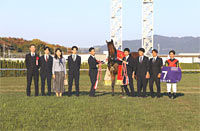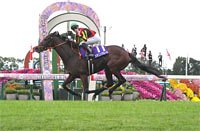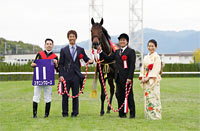2016 News
Queen Elizabeth II Cup (G1) - PreviewAfter a week’s pause in the Grade 1 action, the final slew of top-level racing until the Arima Kinen (The Grand Prix) continues with the Queen Elizabeth II Cup, the race traditionally considered to be the ultimate test for fillies and mares. The Queen Elizabeth II Cup, now in its 41st year, is the latter-day incarnation of the Victoria Cup, begun in 1970 as the final race of the filly triple crown at the time. That race took on the British queen’s name in 1976 to mark Elizabeth II’s visit to Japan the year previous. It originally was open only to 3-year-old fillies and was run over 2,400 meters, but upon the inauguration of the Shuka Sho, was shortened to its current 2,200 meters in 1996 and opened to older horses as well. In 1999, the Queen Elizabeth II Cup opened its gates to foreign-based runners as well and has seen 11 bids by such. The race was won by the Ed Dunlop-trained Snow Fairy in both 2010 and 2011. There are no international contenders in this year’s lineup. Important races leading into this race are the Grade 1 Shuka Sho, held over 2,000 meters at Kyoto and the Grade 2 Fuchu Himba Stakes at Tokyo over 1,800 meters, both held in mid-October. The Takarazuka Kinen, which was held this year on June 26, is also considered to be a good indicator of performance in the Queen Elizabeth II Cup. Although held at Hanshin, it is also run over 2,200 meters. Top finishers in those races set to run on Sunday are Pearl Code, second in the Shuka Sho, Queens Ring, winner of the Fuchu Himba Stakes, and Marialite, winner of the 2016 Takarazuka Kinen and last year’s Queen Elizabeth II Cup champion. All, naturally, are among the top picks. The favorite has only won the race twice in the past decade but has figured in the money eight of those 10 times. The record for the Queen Elizabeth II Cup of 2 minutes, 11.2 seconds, set in 2001, is held by the Sunday Silence-sired To the Victory. The Queen Elizabeth II Cup is the 11th race on the Sunday card of 12 at Kyoto Racecourse and post time is 15:40 local time. Here is a look at the expected top choices: Marialite: The 5-year-old mare Marialite is chasing her third top-level win and the honor of being the fourth horse to win back-to-back versions of the Queen Elizabeth II Cup. Marialite clinched her first Grade 1 win in this race last year and followed that up with a fourth-place finish in the Arima Kinen (The Grand Prix), a mere 0.1 seconds off of winner Gold Actor some five weeks later. This spring, she scored a third in the Grade 2 Nikkei Sho and a second in the Grade 2 Meguro Kinen on Derby Day. In June, she added the Takarazuka Kinen to her score when she beat double classic winner Duramente to the line by a neck. The daughter of Deep Impact currently has six wins to her name and has made the top three spots in 13 of her 18 starts thus far. Returning to the track on Sept. 25, she once again, as she had last year, ran fifth in the 2,200-meter Grade 2 Sankei Sho All Comers. Her finishing order was the same but she was half a second closer to the winner and did it carrying 2 kg more than she was shouldered with last year. She’s expected to improve with that race behind her and word from the Takashi Kubota stable is that, in the hope it’ll add a bit of stimulus, she won’t be running with her usual hood. If she can pull off a double, Marialite will be the first since Snow Fairy to do so. Mejiro Dober in 1998 and 1999 was the first, followed by Admire Groove in 2003 and 2004. Regular jockey Masayoshi Ebina, who has ridden her in 14 of her races and for all of her wins other than her debut winning run, was in the saddle at Miho Training Center on Nov. 2 for morning work. After taking her over 5 furlongs on the woodchip course in 70.7 seconds, Ebina said, “Her best is usually around 68 seconds. She never moves well in work, so I think she’s coming along just fine. But I must say that she doesn’t have the kind of spring in her action that she had around the Takarazuka Kinen. She’s the type of horse that has a hard time switching into gear from neutral. She feels heavy for a bit at first. But the staff is doing its best to have her in good shape.” Ebina has ridden winners in all the Grade 1s for female runners only and he has notched all the Grade 1 races run at Kyoto. Mikki Queen: In the spring, Mikki Queen just missed out on her third Grade 1 win when she was beaten to the line by Straight Girl in the Victoria Mile. Winner of both the Yushun Hima (Japanese Oaks) and the Shuka Sho last year, Mikki Queen has a near perfect record of four wins and five seconds in 10 starts, a record that earned her the JRA Top 3-Year-Old Filly award last year. The only blemish on her record was her eighth in the Japan Cup, after which she was spelled until April. And this year, from a second in the 1,600-meter Hanshin Himba Stakes to a second in the Victoria Mile, Mikki Queen has shown herself to be a versatile runner with a mean turn of foot. Due to a sprain, unfortunately, she was forced to sit out the Grade 2 Kyoto Daishoten as a preliminary to this race and will be racing on Sunday for the first time in six months. Her movement is good of late and she has gotten results coming off a layoff before. “The sprain she suffered delayed her work,” says trainer Yasutoshi Ikee. “But I switched my focus to this race alone and things have gone according to plan. She has gotten better gradually. Compared to the Tokyo mile, the conditions of the Kyoto 2,200 meters are better for her. She’s the type that does well with a sharpener, so we’ll just have to see how she’ll fare this time without.” In the saddle will be Mikki Queen’s regular jockey Suguru Hamanaka, who suffered a fall in February that required three months’ off. The day following his return, Hamanaka rode Mikki Queen to her second in the Victoria Mile. On Nov. 3, he took Mikki Queen up the Ritto Training Center uphill course in tandem, clocking 52 seconds over 4 furlongs with a final lap of 12 seconds. “She’s moving with her usual ease,” he said. “But she has a bit more oomph when she’s at her best. Her breathing is good and I’ll be on her (this) week again, so we’ll see how she does.” Queens Ring: Queens Ring has been handed quite a mix of distances. After finishing second to Mikki Queen by a neck in the Shuka Sho last year, she took on the Queen Elizabeth II Cup, ran into interference twice in the stretch and finished in eighth place, but only 0.3 seconds behind the winner. In late February, she was jumped back down in distance and claimed the Grade 3 Kyoto Himba Stakes over 1,400 meters. Adding a furlong next out she was eighth in the Victoria Mile, then ran second in the open-class Yonago Stakes over the same distance before winning her last start, the Fuchu Himba Stakes over 1,800 meters. “I think she came back well refreshed from her summer off,” trainer Keiji Yoshimura said. “She’s had all the work she needed since coming back to the training center and winning the way she did last out was the most important. I expect her to show improvement this time out.” A daughter of stayer Manhattan Cafe, Queens Ring looks to be able to handle the distance, but has yet to win at anything longer than 1,800 meters. Her last two outings saw Mirco Demuro ride her uncharacteristically forward, with good results, albeit at races 2, 3 furlongs shorter than this one. Give her a smooth run on Sunday and this girl just may be a ringer for the winner’s circle. Touching Speech: The Deep Impact-sired 4-year-old Touching Speech has had four starts this year, none of them winners, but all of them in mixed company, three Grade 2s and a Grade 1. She came closest to winning in the Grade 2 Kyoto Kinen, another 2,200 meter race at Kyoto. She will be coming back refreshed at least, returning to the track without a sharpener for the first time since the Takarazuka Kinen in late June. Back in all-female company will surely be a help and she has the ability, finishing third here last year under Christophe Lemaire just a head and a nose off Marialite. Touching Speech has been partnered with some of the best – Hamanaka, Lemaire and Yuichi Fukunaga – and this week Ryan Moore, fresh off a win of the Tenno Sho (Autumn), is pegged for the ride. Moore rode Snow Fairy to her double wins of the Queen Elizabeth II Cup. He has bagged six Grade 1 races in Japan and will be gunning to make it a lucky seven and two in a row. “Competing against male horses may have been too much for her,” trainer Sei Ishizaka said. “Looking at her last three races, I’d say maybe she still was tired from last year’s hard schedule. But she’s refreshed now and suited to the outer course over 2,200 meters. She’s good over any going though and was third last year. I think she’ll give us a good race this year.” Pearl Code: Late-bloomer Pearl Code only debuted in January, but by April was closing in on the winner’s circle at the Grade 2 level by her fourth star. She came back after nearly five months off for a fifth in the Grade 3 Shion Stakes before taking on the Shuka Sho last out. That race turned the spotlight on her after finishing second and, in doing so, topped Oka Sho champ Jeweler by more than half a length. Both fillies are daughters of Victoire Pisa, but the former has blossomed since the spring. Pearl Code’s big stride and ability to run well at length makes her well-suited to the wide-open Kyoto course. Her six races to date have all been at 1,800-2,000 meters but the extra furlong is considered a plus. She’ll be up against older horses for the first time, but she, along with fellow 3-year-old Denko Ange, will have the 2-kg weight advantage.
|
|
























